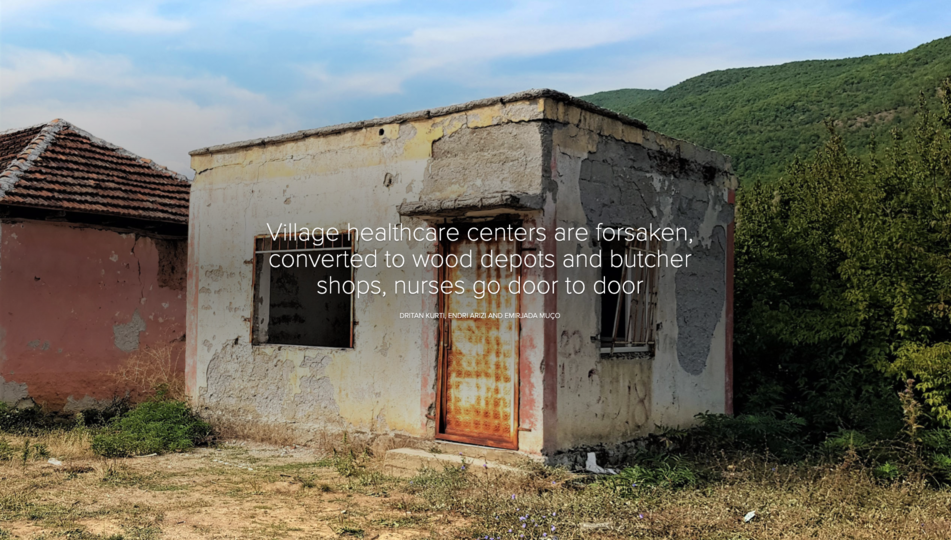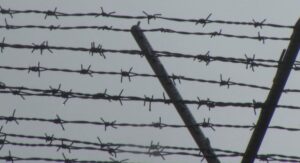To read this article in Albanian click here
Built from the ground up over the last two decades, dozens of healthcare centers in the municipalities of Bulqiza, Tirana and Tepelena have been completely forsaken, while dozens more operate without water and electricity. With a minimum investment value of 1 million ALL, in specific areas it is humanitarian foundations or special individuals who maintain the primary healthcare service.
Authors: Dritan Kurti, Endri Arizi and Emirjada Muço
Residents of Lladomerica, a small, mountainous village in the Ostren Administrative Unit in Bulqiza, have to travel about two hours to get an injection (needle). The outpatient center, built a few years ago, was never put into operation. As a result, residents go to Peshkopi to get health services.
“Disaster! They fired the midwife (nurse), about three or four months ago. We are dying for a lifesaving injection. For an injection we go from here to Peshkopi. That outpatient center there is an illusion because it never worked. I will go directly to Edi Rama for this matter”, 77-year-old Izeir Halili says, irritated, to INA MEDIA.
Next to Northern Macedonia and left in oblivion, the inhabitants of this village demand that at least border be opened for them and that they be given the opportunity to be treated there.
“The border crossing we have nearby is not open to go to northern Macedonia. What more can you say about the village of Lladomericë ?! They work for their own interests, not for ours,” said the old man.

Photo: Dritan Kurti
Due to the lack of primary care service, the inhabitants of Lladomerica complain that the costs they have to pay are too high for them.
“Twice I have been to the emergency room and I paid for the car up to Shupenza. They made the building on the stream, they made it for themselves and they did not ask the village,” says Fatime Manaj, another resident of this village.

Photo: Dritan Kurti
Built in 2001 with a fund of 988,548 ALL, i.e. about 10 million old ALL, the emergency room of the Lladomericë village was never put to work, due to the poor quality of works.
The ease of abuse of public funds is also accepted by the Local Health Care Unit in Bulqiza.
“Built in 2001 in a terrain (stream), unsuitable for use and access by residents and staff, its dilapidation started without even being handed over yet, during the construction period”, – explains LHCU Bulqiza in an official response to Investigative Network Albania and claims that, after the burning of the village school, they are trying to find another solution.

Photo: Dritan Kurti
The inhabitants of the village of Lubalesh, in the Administrative Unit of Gjorica, are also without any kind of health service.

Photo: Dritan Kurti
Without a place to practice, the nurse is obliged to perform door-to-door service for the 300 inhabitants of this village.
Isuf Muha, former mayor of the village of Lubalesh, tells Investigative Network Albania that the health center was built about 10-12 years ago, and is currently totally degraded.
“It may have worked for 4 years, then it did not work anymore. As far as I remember, it may have cost about 10 million old lekë,” Muha told INA MEDIA. – “It completely degraded, as no one cared about maintenance. The nurse comes door to door today. She travels miles from away, day and night, in the rain and snow. There is nothing to do, because this building is totally out of order”, – says in his statement the former mayor of Lubalesh village, Isuf Muha.

Photo: Dritan Kurti
Mustafa Jana accuses that the construction of this facility served only the one who built it and not the community.
“Someone must be held responsible for the wasted money. Those who built it, took the money and disappeared, but no one cares how it was built “, – declares Jana.
Officially, the Bulqiza LHCU informs that this health center was out of use due to problems with the roof.
They further explain that a year ago the project was approved and the donor was found, but the construction of the Lubalesh health center is stalled due to ownership problems.
“We are trying with the municipality to find a solution to this problem,“ LHCU Bulqiza told INA MEDIA.
Humanitarian foundations maintain health centers in Bulqiza
Beyond the motto “Free Healthcare” of the Albanian government, Investigative Network Albania has revealed that the primary service in the Municipality of Bulqiza is maintained by humanitarian organizations and private donors.
Out of 45 health centers located in this municipality, 17 of them have been reconstructed or equipped with health infrastructure with funds coming from outside the state budget, while 6 of them are completely out of order.
More specifically, referring to the response of the LHCU, 7 health centers have escaped closure thanks to donations given by specific individuals and businesses in the area.
5 health centers were built new from the ground up and equipped with all the necessary infrastructure thanks to the humanitarian foundations “Red Crescent”, the foundation “Mirësia” and the foundation of Qatar, “Islamic Relief”.
Thanks to the cooperation with the HAAP project, a project of the Swiss Agency for Development and Cooperation, the procedures for the construction and reconstruction of 5 other health centers are nearing completion, while the Ministry of Health itself has worked on 4 of them, during these 4 years. the latter, intervening in their reconstruction and furnishing.
Built from scratch over the last two decades, according to the Bulqiza Local Health Care Unit, out of 37 health center buildings, 6 of them are completely out of order. In most of them the damage has come as a result of problems with the roof slab, so the Ministry of Health has suggested that they be replaced with tiled roofs.
However, the inhabitants of Bulqiza Municipality also suffer from the lack of nurses and doctors. Although by law there is a need of one doctor per 3000 inhabitants, in many areas the ratio goes to 1 doctor per 8000 inhabitants.
According to health authorities, this lack comes as a result of leaving the country, but also the fact that some young doctors have started specializations.
Dëfrim Zeneli, a nurse, has to cover with medical assistance the inhabitants of the three villages, Tërnovë e Madhe, Tërnovë e Vogël and Smollik in the Administrative Unit Zerqan, in Bulqiza.
The health center of this village was built in 2006 and cost 1,496,170 ALL, but is currently out of order due to problems with the roof slab.

Photo: Dritan Kurti
Zeneli is one of the few primary service employees who agrees to speak publicly and show the absurdity in which he has to practice his profession.
“From Tërnova e Madhe to Vogël it takes an hour and a half on foot, while in Smollik, 1 hour. The terrain is very difficult, especially in the winter season. When we have therapy, the work is more difficult, as you have to go to the patient twice a day. In winter, all car roads are blocked, while I remain as the only viable option for the health service for all residents,” he said.
He serves about 400 inhabitants, while for the payment he says that it is not worth working.
“Payment is made based on the number of inhabitants, but we work for humanity, because it is not worth the salary. I know the conditions and needs of the people and I am obliged to serve them. For me there is no work schedule. People appreciate me and this inspires me even more in my work,” Dëfrim Zeneli told INA MEDIA.

Photo: Dritan Kurti
Here, too, the residents are grateful to the nurse, who goes to their home for every need.
“We are in debt with the village nurse, who is tireless. Even when the snow reaches up to 1.5 meters, he comes to our houses. As far as that health center is concerned, we have not seen a single good thing from it,” said Shemsi Xhafa, a resident of Tarnova.
In the village of Godvi in Zerqan, the health center has been turned into a firewood depot. This building was built in 2003 and cost the state budget 995,767 ALL. According to LHCU Bulqiza, “the damage to the roof slab brought serious damage to the armature, while currently the service is provided in a building built as a garden and health center for his village by father Ismail Jangulli”.
“It worked for some time, then the roof slab started to drip and then it did not work anymore. Currently we do not have any health service, as the nurse we had left for Bulqiza. We are about 100 inhabitants who have nowhere to get even a shot,” said 68-year-old Hasan Seiti.
In addition to destitution, the Bulqiza LHCU acknowledges that some health centers also lack running water and electricity.
They admit that there are problems with staff. For about 40 thousand inhabitants that this municipality has, the Primary Health Service should have 13 doctors on duty, but currently there are only 7 doctors, leaving three units, such as Zerqan, Trebisht and Ostren, without family doctors.
In these units, the doctor of the other units visits once a month. Also, out of 108 necessary nursing staff, only 100 are on duty.
The paradox in the suburbs of Tirana, completely abandoned
Unlike the splendor of the capital, Investigative Network Albania’s research has revealed that residents of Tirana’s suburbs have been suffering for decades from the same bitter reality: total abandonment of health services.
In the village of Bastar i Mesëm, where about 300 families live, the health center has been turned into a meat shop and is not functioning at all. Paradoxically, the building built in 2015, worth 983,971 ALL, shows no damage whatsoever.
Residents confess that it serves only to keep the meat of the village butcher, who has placed a refrigerator inside the health center, as adjacent to it there is the slaughterhouse.

Photo: Endri Arizi
“The Health Center does not function, there is no family doctor. They never show up. For any health problems we have, we head to Tirana. I have an 86 year old mother and she needs serum. I hire a private doctor to do a serum, because I have nowhere to take her “, – says Vehbi Kurti for INA MEDIA, who explains that the situation is even more dramatic because of the road.
“We have difficulties going to Tirana, because we have neither roads nor cars. In winter, it does not work at all. It is totally blocked,” he complains.
There are also problems with the Primary Health Service in the Baldushk Administrative Unit. In the village of Koçaj, the health center built several years ago is not functioning. The building is surrounded by thorns and bushes, while the windows are broken, despite the fact that medical equipment is found inside.
Residents of the area say they have never used the health center, as the nurse provides them with home care. On the other hand, they say the building degraded more during the pandemic.
“It was functional till last year, despite the fact that we did not use it much, because we went to the other doctors. When we ask for him, he comes to our homes, he always comes”, – claims for Investigative Network Albania the Klevis Kasa, resident of Koçaj village.

Photo: Endri Arizi
The outpatient center of Vishaj village in the Administrative Unit of Vaqar is also out of order, although very close to the capital. In its official response, the Local Unit of Health Care Tirana highlights only the facilities, in which it has invested in the last three years, but does not provide any data on the value of the construction of buildings of health centers or outpatients.
From the long list of health centers that have benefited from reconstruction and have been equipped with the necessary furniture during the years 2018-2020, it seems that the Municipality of Tirana has received large funds for primary service, improving the infrastructure in 38 of them. While the other 20 are equipped with furniture and material base during 2021.
The Municipality of Tirana says that the facilities in question are not included in the inventory of public facilities owned by the municipality, while it explains that the outpatient building of the village of Bastar i Mesëm has cost 983,971 ALL in construction, creating a contradiction with itself.
Memaliaj is completely abandoned, retired doctors still working
In the Municipality of Memaliaj the situation is even worse. The Local Unit of Health Care Tepelena, which also covers this municipality, officially explains that out of 48 outpatient centers that this municipality should have, 28 of them are either not functional or do not exist at all.
The paradox continues even for those that are functional.
“In the other 20, which are functional, there is a lack of water, because there is no water supply network and they are without electricity, because, since they were built, there has not been a connection point”, – it is said in the official response of LGU Tepelena.
Found in this absurd situation, it seems that this unit takes care to underline that, unlike clinics, health centers have water and electricity.
“5 health centers operate in good conditions with water and electricity”, – said in the official response to INA MEDIA, when water supply and electricity is a legal obligation.
LHCU Tepelena avoids responsibility for the facilities, blaming the local government in Memaliaj.
With a pronounced lack of medical staff in the abandoned Municipality of Memaliaj, the primary health care service is sustained by retired doctors.
The information of LHCU Tepelena is provided only for the health centers, which are functional, although with various problems, where in some of them there is no ambulance for transporting the sick.
The Municipality of Memaliaj also does not have an investment inventory, although every document of the former communes has been transferred to the municipalities with the new Territorial Administrative Reform of 2014.

Photo: Emirjada Muço
There is no outpatient center in the villages of Anë Vjosë and Zotaj of the Qesarat Administrative Unit. The nurse, who covers these two villages, Adelina Shehu, has turned one of the rooms of her apartment into a center and a pharmacy to keep the medicines.
“I opened the room to wait for patients. I have no closet, no tools, no gloves, nothing. I keep everything in a bag here at home. These conditions are not normal, but I CAN’T DO ANYTHING. I requested the activation of the health center. These residents have no service”, – Adelina tells Investigative Network Albania.
The situation is also problematic in the village of Koshtan. Nurie Resuli says that they have to pay for private transport for every health service up to Gjirokastra, which costs 3 thousand new lek.

Photo: Emirjada Muço
“The health service building is in ruins. I myself am sick and in these conditions I am forced to move through the villages on foot and by private means to make get a shot. The village has been forgotten by the government. “Today, in order to benefit from a health service, we are obliged to pay privately for a car, which costs 3 thousand new lek,” said Resuli.
Hetem Zholaj says that the outpatient building was “occupied” by a resident and there is no health service in the village. For every need they go to Tepelena, paying privately.
“The health center is completely destroyed, it is occupied by one person. We tried our best to fix it to some extent, for the nurse to come. Today it is out of order. We filed a complaint in Tepelena and Vlora, but it was not solved as a problem, “Zholaj emphasizes.
For the former Minister of Health, Petrit Vasili, the provision of services in apartments is damaging, not only to the patient, but also to the health personnel who provide it.
“Absolutely, the service should be provided in a dedicated structure. A structure, even the smallest one, has a sterilization structure, it has the means of protection of the staff, but also of the patient; has the way a patient will be placed, who will receive services, in an ordinary, outpatient bed. All other structures will never be a good service, they will carry other risks and the consequences fall on the patient, but there are many of these consequences for the staff as well”, – former Minister Vasili analyzes the situation.
Primary service, no money for 2021
At the height of the pandemic, primary care faced a large influx of patients with Covid-19, but, nevertheless, it seems that in dealing with the disease of the century, the funds given for this budget line are extremely minimalist compared to the needs.
The Ministry of Health and Social Protection explains in its response to Investigative Network Albania that it has set aside about 2 million euros (235 million ALL), for investments in facilities and equipment in the Primary Health Service sector.
This figure is about 20% of the total budget of about 84 million euros that the ministry has allocated to this service.
But, from this money, the ministry itself admits that it has not allocated any penny for investments to LHCU Tirana, Bulqiza and Tepelena (LHCU Tepelena covers the Municipality of Memaliaj).
“LGU Tirana, Bulqiza and Tepelena have been allocated the total budget value for 2021 in the amount of 59,918,879 ALL. This value includes only current expenditures, because no investments have been foreseen for 2021 “, – explains the Ministry of Health in a response to information for INA MEDIA.
Despite many promises, health continues to be a priority only on paper.
Albania’s budget for health is extremely minimalist compared to the countries of our poor region.
During 2021, the Albanian government has allocated 13.7 million euros less to this health sector than Kosovo, which in the same year has allocated 97.7 million euros for primary services.
Compared to the population of both countries, Kosovo’s budget for this sector is almost twice as large as that of Albania.
Montenegro, which has a population of approximately 700 thousand inhabitants, has made available to the Primary Health Service 46 million euros or 65 euros / person. Compared to the population, Albania has twice less funding for this service as Montenegro, which allocated a budget of 34.8 euros / person.
Montenegro has allocated to the health system as a whole a budget of 304 million euros, Kosovo 240 million euros and Albania, apparently with a larger budget, 682 million euros, but most of this budget is for protection schemes, social assistance, such as economic assistance or payment of persons with disabilities.
Dissatisfied with the attention being paid to primary care, former Minister Vasili suggests that, in poor countries like ours, it is an emergency to increase the capacity of the primary healthcare system.
“The poorer the system, financially, as a whole, the more the primary system becomes its solution. Increasing the capacity of the primary service makes it possible for many problems to be caught much faster, not to be aggravated, to aggravate the costs of the system, which, being poor, cannot afford. So, for us as a country, the development of the primary service and its flourishing, investing in it practically means keeping the health system afloat “, – suggests Vasili.





